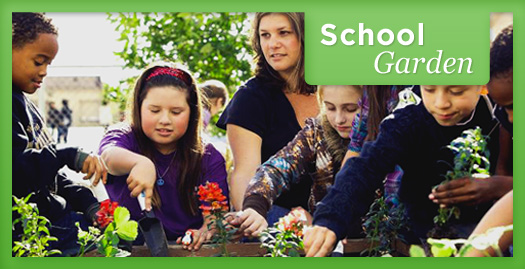
School Garden Checklist
Whether you're looking for a new way to capture your students' interest as the weather breaks or you simply need to add some life to your classroom or school, planting a school garden will do the trick.
School gardens offer opportunities for fun and physical activity while serving as an important educational tool to help students understand how healthy food is produced.
Before you start a garden of your own, read and download this step-by-step guide, which offers important information about how to safely grow your own fruits and vegetables with your students:
Site Selection
Finding the best location for your garden project will require some investigation. Tarmac, dry earth, mud, and empty fields can be turned into green grounds, outdoor laboratories, vegetable plots, herb gardens, play spaces and study areas. Use these questions to guide your thinking, and then decide on the garden location accordingly.
- Is the site easy and safe for both students and teachers to access?
- Is there a nearby and dependable water source?
- Is the site protected from vandals, rodents or other potential threats?
- Is the area big enough to allow for future growth?
- Is the site exposed to sunlight at least 6 hours a day, if planting flowers, herbs and vegetables?
- Is the soil contaminated with lead or other heavy metals?
Parking lots, courtyards, rooftops, greenhouses, and schoolyards can all be potential sites. If it is not possible to have a garden at the school, consider options within the community like city parks or vacant lots, places of worship, nature centers, retirement centers, and community gardens. You will want to avoid locations that are exposed to nearby pollutants like highways, airports, industry smokestacks, or areas referred to as brownfields. If space is very limited, consider gardening in containers. You might even find that the ideal spot is indoors instead of outside.
Soil Health
Soil is the foundation on which gardens are built. Good soil is an essential ingredient in a healthy school garden. It’s important to collect soil samples to identify the soil quality of the proposed garden site. Have your soil tested for pH, nutrients, and lead contamination by a soil testing laboratory. If your site is contaminated, the simplest solution may be to find another site or try container gardening with different soil. Contact your nearest Cooperative Extension office to learn how to take a soil sample and where to send it for analysis.
Designing for Students
Engage the entire school community including parents, students at every grade level, teachers, administrators, food service staff, and local partners in the design of the garden. Hold a brainstorming session where everyone gets to share ideas and design concepts. Develop a design plan that students will find interesting and exciting. The school grounds can be:
- a source of food for improving children’s diet and nutrition
- a source of healthy influences -- physical activity, ingredients for school meals
- an area of learning -- about nature, agriculture, nutrition, math, and other subjects
- a place of pleasure and recreation -- flowers and shrubs, play areas, shade, eating areas
- a continuing lesson in respecting the environment and taking pride in one’s school
- a gathering spot for your community to socialize
Plant Palette
Have older students survey younger students about what plants to grow. Choose a palette of plants that are safe (no poisonous fruits, large thorns or weak limbs), healthy (resistant to disease or pests), low maintenance, desirable in size and shape, and suitable to your climate. You can select plants based on a theme, such as a storybook or science lesson, to connect with what is being taught in the classroom. Selecting appropriate plants requires knowledge of what plants will survive and grow year after year in your region of the United States. Do you know your growing zone? Use the USDA Plant Hardiness Zone Map to find out.
Resources
Forming local partnerships is an excellent way to leverage resources and gain access to needed materials, tools, funding, volunteers, and technical assistance. USDA’s People’s Garden website has how-to videos and databases filled with garden-based learning curricula, free seed and funding sources, and healthy gardening practices. You can call on an Extension Master Gardener volunteer in your area to help with your garden. The long-term success of your school garden will depend a great deal on relationships with partners. Many hands make light work!
Build and Use the Garden
Encourage students to share their ideas and include them in the building and planting of the garden – get their hands in the soil every step of the way. Their participation will instill a sense of ownership, pride, and responsibility among students. Teachers and garden leaders should provide activities that keep all kids engaged. Use the garden to connect students to the source of their food. Plant herbs, fruits, and vegetables that are easy to grow, pick, and cook and you’ll succeed at introducing a greater variety of fruits and vegetables to youth.
Information provided courtesy of USDA’s People’s Garden Initiative. For more gardening resources visit: www.usda.gov/peoplesgarden.

